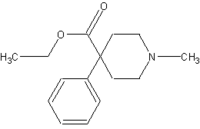Demerol
Pethidine (INN) or meperidine (USAN) (also referred to as: isonipecaine; lidol; operidine; pethanol; piridosal; Algil®; Alodan®; Centralgin®; Demerol®; Dispadol®; Dolantin®; Dolestine®; Dolosal®; Dolsin®; Mefedina®) is a fast-acting opioid analgesic drug. In the United States, it is more commonly known as meperidine or by its brand name Demerol. more...
Pethidine is used to deal with moderate to severe pain, and is delivered as hydrochloride tablets, as a syrup, or by intramuscular or intravenous injection. Because pethidine has the potential to be both physically and psychologically habituating, it is important that it be used in only the doses prescribed, and that withdrawal from the drug be supervised by a physician to ensure there are no adverse reactions.
Mode of action
Pethidine has effects similar to morphine, but has very little effect on cough or diarrhea. Pethidine is more lipid-soluble than morphine resulting in a faster onset of action. It duration of clinical effect is 120-150 minutes. In addition, it has a slight antimuscarinic effect.
Pharmacokinetics
Pethidine is quickly hydrolysed in the liver to pethidinic acid and is also demethylated to norpethidine, which has half the activity of pethidine but a longer elimination half-life; accumulating in renal failure. Norpethidine is toxic and has convulsant and hallucinogenic effects. The toxic effects mediated by the metabolites cannot be countered with opioid receptor antagonists such as naloxone or naltrexone. The neurotoxicity of pethidine's metabolites is a unique feature of pethidine compared to other opioids. Pethidine's metabolites are further conjugated with glucuronic acid and excreted into the urine.
Interactions
Pethidine interacts with a number of other medications, including muscle relaxants, antidepressants, benzodiazepines, and alcohol. It is especially dangerous to use if the patient is using monoamine oxidase inhibitor (MAOI) type antidepressants. Such patients may suffer agitation, delerium, headache, convulsions, hyperthermia. It is thought to be caused by an increase in cerebral serotonin concentrations.
Pethidine is also relatively contraindicated for use when a patient is suffering from gallbladder, liver, or kidney disease, has a history of seizures or epilepsy, has an enlarged prostate or urinary retention problems, or suffers from hyperthyroidism, asthma, or Addison's disease.
Adverse effects
Users of pethidine may experience serious adverse effects. These include asthma, swelling of the mucous membranes of the nose and throat, swelling of the lips, tongue, or face, seizures, cold and clammy skin, or dizziness and possible unconsciousness. The presence of any of these side effects is an indicator to stop using pethidine immediately and seek immediate medical attention.
Less serious side effects include constipation, dry mouth, lightheadedness, itchiness, muscular twitches, and nausea.
Read more at Wikipedia.org



